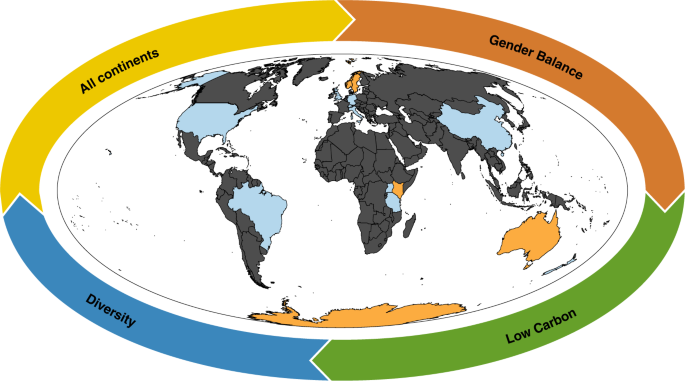
We believe that the ABCD conference format will not only connect people but also create trust within the scientific community, enabling better exchange of ideas and increased impact in working towards solutions, be it the effects of global climate change, regional biodiversity loss, or in any other field of research. We recently tested this format in the session on ‘Aquatic Biodiversity: state and challenges ahead’, organized and held at the World Biodiversity Forum from 22 to 28 February 2020 in Davos, Switzerland. Prior to the session we gave invited speakers the option of live-streaming, pre-recording or attending via low carbon emission transport to deliver their presentation. On the day, we had presentations in all three formats which gave an overview on the state and threats to aquatic biodiversity, discussed the underlying drivers, and outlined how this affects the ecological and evolutionary functioning of the ecosystems. Here, we give our first-hand experience of the gains but also challenges we experienced from the organizers’ and speakers’ perspective:
Organizers
As organizers aiming to meet the four criteria set out under the ABCD format, we quickly realized constraints due to the limited reach of our own professional networks. Institutions in the ‘West’ with additional strongholds in Asia and only relatively few researchers elsewhere dominate aquatic biodiversity representation. Not only are our own networks highly biased, but we realized that the relatively isolated researchers in the field outside the stronghold regions are not well networked amongst themselves either. We therefore needed to reach out beyond our own established networks and those of our contacts elsewhere, which led to a number of ‘dead-ends’ with no responses from potential candidates. Our attempts to have gender balance turned out to be especially challenging, and several female speakers invited unfortunately did not respond to our request for unknown reasons. Those who did not respond to our request may not have in part due to our novel request to participate in a session without physical attendance or networking, which is often a key reason to attend conferences. Such constraints may be overcome in the future by increased awareness of the aims of the ABCD format and through ‘directed growth’ of our own professional networks beyond our immediate geographic or scientific vicinity.
Running the session
By using live-streaming and pre-recorded talks, all speakers not attending in person were suitably prepared to present on the day. By using these methods, additional consideration needs to be taken for timing, particularly with remote talks running over time. This can be addressed by the addition of web cameras faced at both presenter and audience, enabling the chair to communicate the time allowance. In our session, we promoted discussion via social media and an online conference question platform. However, we got only a few discussion points from this, which may be due to the novel concept and may likely evolve if this method becomes more common. One way to increase discussion could be to make questions of the audience visible to both speaker and audience in a live ticker, as is already possible in some video conferencing programs.
Speakers
Contributors to the session were introduced to the ABCD format and the goals of the session when being invited to participate. This is key and perhaps cannot be overemphasized when organizing a session using the ABCD format. Several participants highlighted the potential for networking and discussion as an area for improvement. This can be addressed with further engagement, such as pre-conference discussion among the speakers, increased engagement with online discussion tools, and an increased familiarity of presenters/attendees with this new format.
Outcomes
By using the ABCD conference format, the session encompassed a nuanced attitude and recognized some new key areas of research across geography. A number of remote and pre-recorded speakers highlighted that they felt comfortable presenting their research using these methods, and that it enabled contributions and opportunities which would not have existed otherwise. (See Box 1 for further information on ABCD format planning.)
Our session focused on the state and change of freshwater ecosystems in the context of global change. Rivers and lakes are among the most biodiverse ecosystems worldwide and provide essential resources and services for humans, including drinking water, fisheries, transport or recreation. However, they are also globally among the most threatened ecosystems10. A highlight of our session was the identification of overlapping key findings and hitherto missing links between different initiatives that would likely not have emerged at this point in time without the ABCD approach. As an example, the session identified missing links between biodiversity data mobilization initiatives in different parts of the world (for example, the Freshwater Biodiversity Observation Network (FreshwaterBON) having a stronghold in Europe, while JRS Biodiversity Foundation and the Global Biodiversity Information Facility (GBiF) dominate in Africa) and the respective stakeholders and scientists. It also became obvious that finding solutions to the multiple risks threatening freshwater biodiversity11 is in large parts of the world challenged by lack of basic data (due to a paucity of species identification experts and funding), lack of access to databases, and lack in common protocols. A discrepancy between limiting factors and necessary solutions was matched by backgrounds of attendees, showing that only an inclusive approach allows discussions about possible ways forward that create impact beyond the regional realm.
Source: Ecology - nature.com



